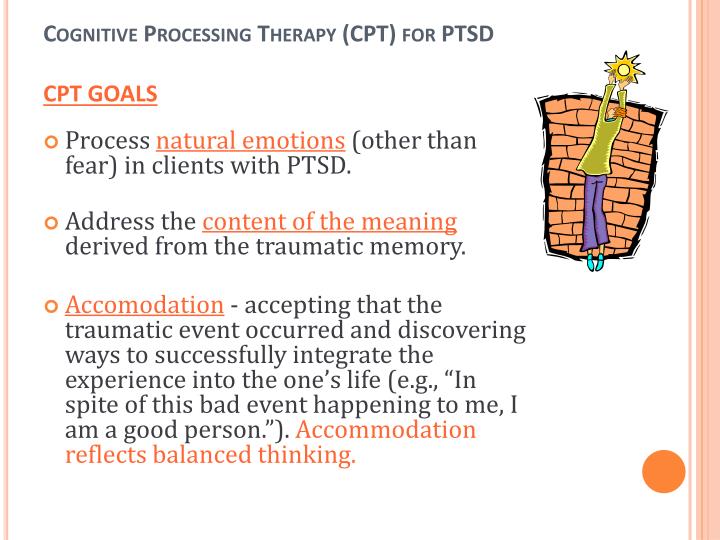Cognitive Processing Therapy Techniques
Cognitive Processing Therapy Techniques - Focuses on identifying “stuck points” related to. Cpt is a cognitive behavioral therapy that helps patients modify and challenge unhelpful beliefs related to the trauma. Cognitive processing therapy (cpt) is a manualized therapy used by clinicians to help people recover from posttraumatic stress. Combines cognitive therapy (changing thoughts) and behavioral therapy (changing behaviors).
Combines cognitive therapy (changing thoughts) and behavioral therapy (changing behaviors). Cpt is a cognitive behavioral therapy that helps patients modify and challenge unhelpful beliefs related to the trauma. Cognitive processing therapy (cpt) is a manualized therapy used by clinicians to help people recover from posttraumatic stress. Focuses on identifying “stuck points” related to.
Focuses on identifying “stuck points” related to. Combines cognitive therapy (changing thoughts) and behavioral therapy (changing behaviors). Cpt is a cognitive behavioral therapy that helps patients modify and challenge unhelpful beliefs related to the trauma. Cognitive processing therapy (cpt) is a manualized therapy used by clinicians to help people recover from posttraumatic stress.
A Guide to Cognitive Behavioural Therapy The International Psychology
Cpt is a cognitive behavioral therapy that helps patients modify and challenge unhelpful beliefs related to the trauma. Cognitive processing therapy (cpt) is a manualized therapy used by clinicians to help people recover from posttraumatic stress. Focuses on identifying “stuck points” related to. Combines cognitive therapy (changing thoughts) and behavioral therapy (changing behaviors).
Cognitive Processing Therapy Techniques and Efficacy
Focuses on identifying “stuck points” related to. Cognitive processing therapy (cpt) is a manualized therapy used by clinicians to help people recover from posttraumatic stress. Combines cognitive therapy (changing thoughts) and behavioral therapy (changing behaviors). Cpt is a cognitive behavioral therapy that helps patients modify and challenge unhelpful beliefs related to the trauma.
Cognitive Processing Therapy Examples
Focuses on identifying “stuck points” related to. Cognitive processing therapy (cpt) is a manualized therapy used by clinicians to help people recover from posttraumatic stress. Combines cognitive therapy (changing thoughts) and behavioral therapy (changing behaviors). Cpt is a cognitive behavioral therapy that helps patients modify and challenge unhelpful beliefs related to the trauma.
Cognitive Processing Therapy YouTube
Focuses on identifying “stuck points” related to. Cpt is a cognitive behavioral therapy that helps patients modify and challenge unhelpful beliefs related to the trauma. Cognitive processing therapy (cpt) is a manualized therapy used by clinicians to help people recover from posttraumatic stress. Combines cognitive therapy (changing thoughts) and behavioral therapy (changing behaviors).
Navigating Trauma Recovery A Comparative Analysis of Cognitive
Combines cognitive therapy (changing thoughts) and behavioral therapy (changing behaviors). Focuses on identifying “stuck points” related to. Cognitive processing therapy (cpt) is a manualized therapy used by clinicians to help people recover from posttraumatic stress. Cpt is a cognitive behavioral therapy that helps patients modify and challenge unhelpful beliefs related to the trauma.
Cognitive Behavioral Therapy (CBT) Types, Techniques, Uses
Combines cognitive therapy (changing thoughts) and behavioral therapy (changing behaviors). Focuses on identifying “stuck points” related to. Cpt is a cognitive behavioral therapy that helps patients modify and challenge unhelpful beliefs related to the trauma. Cognitive processing therapy (cpt) is a manualized therapy used by clinicians to help people recover from posttraumatic stress.
Cognitive Processing Therapy for PTSD PostTraumatic Stress Disorder
Combines cognitive therapy (changing thoughts) and behavioral therapy (changing behaviors). Focuses on identifying “stuck points” related to. Cpt is a cognitive behavioral therapy that helps patients modify and challenge unhelpful beliefs related to the trauma. Cognitive processing therapy (cpt) is a manualized therapy used by clinicians to help people recover from posttraumatic stress.
Infographic Cognitive Behavior Therapy Cognitive therapy, Cognitive
Combines cognitive therapy (changing thoughts) and behavioral therapy (changing behaviors). Cognitive processing therapy (cpt) is a manualized therapy used by clinicians to help people recover from posttraumatic stress. Cpt is a cognitive behavioral therapy that helps patients modify and challenge unhelpful beliefs related to the trauma. Focuses on identifying “stuck points” related to.
Cognitive Behavioral Therapy Clayton Therapy Peggy Levinson
Focuses on identifying “stuck points” related to. Cognitive processing therapy (cpt) is a manualized therapy used by clinicians to help people recover from posttraumatic stress. Combines cognitive therapy (changing thoughts) and behavioral therapy (changing behaviors). Cpt is a cognitive behavioral therapy that helps patients modify and challenge unhelpful beliefs related to the trauma.
PPT Cognitive Processing Therapy (CPT) for PTSD Ashlee Whitehead, LPC
Cognitive processing therapy (cpt) is a manualized therapy used by clinicians to help people recover from posttraumatic stress. Focuses on identifying “stuck points” related to. Combines cognitive therapy (changing thoughts) and behavioral therapy (changing behaviors). Cpt is a cognitive behavioral therapy that helps patients modify and challenge unhelpful beliefs related to the trauma.
Cpt Is A Cognitive Behavioral Therapy That Helps Patients Modify And Challenge Unhelpful Beliefs Related To The Trauma.
Cognitive processing therapy (cpt) is a manualized therapy used by clinicians to help people recover from posttraumatic stress. Focuses on identifying “stuck points” related to. Combines cognitive therapy (changing thoughts) and behavioral therapy (changing behaviors).

:max_bytes(150000):strip_icc()/Cognitive-processing-therapy-2797281-v4-2809edaec5d54fd7836df4d006856baa.png)



/what-is-cognitive-behavior-therapy-2795747_final-a977e311cb8e471390666df948e873c3.png)



